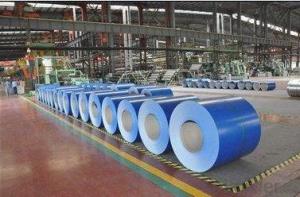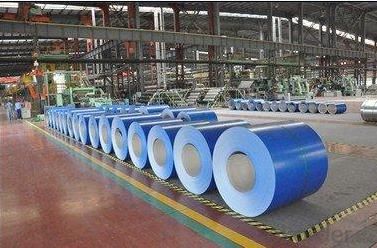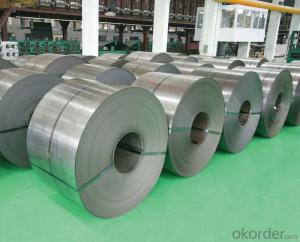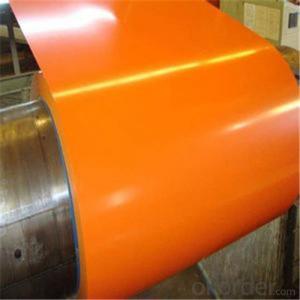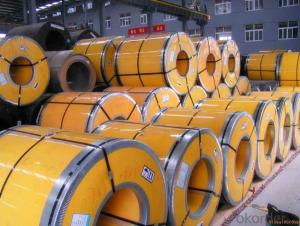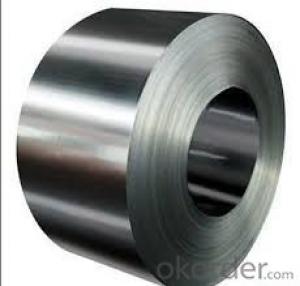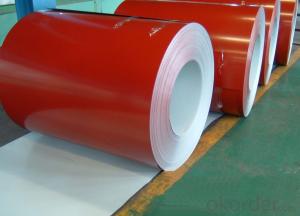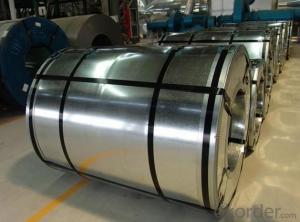Cold Rolled Steel Coil with Colored Coated Staniless
- Loading Port:
- Shanghai
- Payment Terms:
- TT OR LC
- Min Order Qty:
- 25 m.t.
- Supply Capability:
- 8000 m.t./month
OKorder Service Pledge
OKorder Financial Service
You Might Also Like
Cold Rolled Steel Coil :
| Standard: | AISI,ASTM,GB,JIS |
| Thickness: | 0.25-0.8MM |
| Technique: | Cold Rolled |
| Surface Treatment: | Coated |
| Application: | Roofing |
| Special Use: | Silicon Steel |
| Width: | 800-1250MM |
| Color: | Ral or according to sample |
Packaging & Delivery
| Packaging Detail: | color steel coil STANDARD EXPORT SEAWORTHY PACKING |
| Delivery Detail: | within 30 days |
Specifications
color steel coil
Prime Quality, Quick Delivery, Competitive Price
Prepainted Galvanized Steel Coil (PPGI/PPGL)
Base material: Hot dipped galvanized steel
Width: available from 800MM to 1250MM
Width Tolerance: within 0.02MM
Thickness: available from 0.18MM to 0.80MM
Thickness Tolerance: within 0.15MM
Performance: Smooth or Matte
Color: according to RAL standard
Lacquer Coating thickness: according to customer needs
Supply capacity: 8,000 Metric Ton per month
Our products has good performance on combining force and anti-erosion. We offer fine quality products and best price for our international customers.
- Q: What are some characteristics of steel.
- Characteristics Of Steel Hardening. - The characteristic difference between steel and pure wrought iron is as follows: - When steel is raised to a red heat and then suddenly cooled, it becomes hard and brittle. This process, which is known as hardening, has no effect upon pure wrought iron. Tempering is a characteristic of steel which distinguishes it from cast iron. If steel has been hardened by being heated and suddenly cooled, as above described, it may be softened again by applying a lower degree of heat and again cooling. This is known as tempering. Cast iron, on the contrary, though it is hardened by the first process, cannot be softened by the second. When a bar of steel is struck it gives out a sharp metallic ring, quite different from the sound produced by striking wrought iron. Other characteristics of steel are its great elasticity and its retention of magnetism.
- Q: How are steel coils used in the manufacturing of automotive hoods?
- Steel coils are used in the manufacturing of automotive hoods as they are shaped and formed into the desired hood design. These coils are processed through various stages such as cutting, stamping, and welding to create the hood's structure. The strength and durability of steel make it an ideal material for automotive hoods, ensuring they can withstand impacts and provide protection to the engine compartment.
- Q: Suppose you made a sword out of diamond (just follow me here, it's only theoretical). Would it be lighter than a sword of the same size made out of steel?
- steel is heavier. 6.5 mm/1 carat of steel is 7 grams, while diamond is 1/5 a gram
- Q: What are the different methods of protecting steel coils from corrosion?
- Some common methods of protecting steel coils from corrosion include applying a protective coating or paint, using corrosion inhibitors, implementing cathodic protection systems, and storing the coils in a controlled environment with low humidity and proper ventilation.
- Q: How are steel coils used in the production of automotive stampings?
- Steel coils are an essential component in the production of automotive stampings. These coils are typically made from high-quality steel and are cut into specific widths and lengths to meet the requirements of automotive manufacturers. The first step in using steel coils for automotive stampings is to uncoil the steel. This is done using a machine called a decoiler, which unwinds the coil and feeds it into the stamping machine. The decoiler ensures a continuous supply of steel for the stamping process. Once the steel coil is unwound, it is fed into the stamping machine, which is equipped with a die that shapes the steel into the desired automotive component. The die is designed to create precise and complex shapes, such as car body panels, doors, fenders, or structural components. The stamping machine applies force to the steel coil, pressing it against the die and forming it into the desired shape. The high-quality steel used in the coils ensures that the stamped components have the necessary strength and durability required for automotive applications. After the stamping process, the stamped components are inspected for quality and precision. Any imperfections or defects are identified and corrected before the components are sent for further processing, such as painting, welding, or assembly. Overall, steel coils play a crucial role in the production of automotive stampings. They provide a continuous supply of high-quality steel, which is shaped into precise and durable automotive components. The use of steel coils ensures that the automotive stampings meet the required standards for strength, durability, and precision.
- Q: When I took guitar lessons, I found that the Nylon strings are easier for me, but I love the sound of steel strings. Now, I have my own acoustic guitar, and 2 strings broke off, so I'm getting strings today. I'm not sure if Nylon strings would 'fit' on my guitar, and it's to soft of a noise. But the steel are much better sounding, but it's a little bit harder to push the string down on the fret. Which do you prefer, why?(:
- You cannot put nylon strings on a steel-stringed guitar. If you find that the steel strings are too hard, get a lighter gauge which will ease up the tension. This way you can build up finger strength gradually as well as build up the callouses on your finger. You can always get a thicker gauge string later on if you want a deeper sound.
- Q: How are steel coils inspected for straightness?
- Steel coils are inspected for straightness through a variety of methods to ensure they meet the required quality standards. One common method is visual inspection, where trained inspectors visually examine the coil for any visible defects or deformations that may indicate a lack of straightness. They carefully observe the coil's edges, surface, and overall shape to identify any irregularities. Another method used is measuring the coil's straightness using precision instruments. This involves taking measurements at various points along the coil's length and comparing them against specified tolerances. Techniques such as laser measurements or straightness gauges are employed to accurately assess the deviation from the desired straightness. Furthermore, some coils undergo non-destructive testing, such as magnetic particle inspection or ultrasonic testing, to identify any internal defects or stresses that could affect the straightness. These tests can reveal hidden flaws that may not be evident through visual inspection alone. In addition, some manufacturers may employ automated inspection systems that utilize advanced technologies like computer vision or artificial intelligence. These systems can quickly scan the coil's surface and analyze it for any deviations from straightness, providing precise measurements and ensuring consistent quality. Overall, the inspection of steel coils for straightness involves a combination of visual inspection, precise measurements, non-destructive testing, and advanced technologies. These methods aim to identify any deviations from the required straightness, ensuring that only coils meeting the specified standards are used in various applications.
- Q: What brand steel tapes are of good quality?
- Durable durable depends on your personal use frequency, the high frequency nature is easy to wear, resulting in scale. If you like fuzzy units if buying tape need verification it is best to buy the Great Wall Seiko goods, because the time to measure the number of verification inspection of steel tape, basically qualified rate of the Great Wall Seiko steel tape can reach one hundred percent.
- Q: Is there a chemical that can be applied (spraid, brushed, adhere) to a steel surface to decrease the heat conductive properties of the metal (so it doesn't heat up as quickly)?Thanks in advance!
- There is, but I don't know what it is made out of. It is probably some fireproof, foam material which acts like insulation. I doubt it is designed to resist abrasion however. Most things which adhere to metal surfaces are not flameproof, and those which do resist fire are not good insulators. For example, the ceramic coating of appliances like stoves and washing machines adhere very well and are fire resistant, but do not insulate. It was the failure of the steel insulation which caused the collapse of the world trade centers. The impact of the airplane tore away all the insulation on the supporting struts of the building and then the fire caused the steel to soften and break. Steel was once insulated by wrapping it in asbestos cloth and then applying plaster over this to form a shell. It did not actually adhere to the steel but it did insulate it, and was fireproof. However asbestos is a cancer hazard and a lot of old buildings are being stripped of their asbestos as a safety precaution. The asbestos can be replaced with fiberglass which is usually duct taped together.
- Q: How are steel coils coated to prevent rust and corrosion?
- Steel coils are coated to prevent rust and corrosion through a process called galvanization. This involves immersing the coils in a bath of molten zinc, which forms a protective layer on the steel surface. This zinc coating acts as a barrier, preventing oxygen and moisture from reaching the steel and causing rust. Additionally, the zinc coating provides sacrificial protection, meaning that even if the steel is exposed due to scratches or abrasions, the zinc will corrode before the steel, further enhancing its longevity and resistance to rust and corrosion.
Send your message to us
Cold Rolled Steel Coil with Colored Coated Staniless
- Loading Port:
- Shanghai
- Payment Terms:
- TT OR LC
- Min Order Qty:
- 25 m.t.
- Supply Capability:
- 8000 m.t./month
OKorder Service Pledge
OKorder Financial Service
Similar products
Hot products
Hot Searches
Related keywords
